Ozoni is a mochi soup eaten on New Year’s Day in Japan.
Japanese New Year’s events and food originated in Shintoism, and various customs were born from the idea of “kami-jin-kyoshoku (神人共食),” which means to eat food offered to the gods to receive the power of the gods and to be more energetic. Ozoni began as a stew of rice cakes, made of agricultural and marine products to be offered to the New Year’s gods (年神様).

However, ozoni differs from region to region, and the ingredients used also vary from region to region. There are only two main components common to ozoni in all regions of Japan. One is mochi (rice cake), and the other is dashi (soup stock).
Mochi used for ozoni
Mochi comes in two shapes: round and square. Generally, round mochi are used in West Japan, while square mochi are used in East Japan. Interestingly, the boundary between round and square mochi is said to lie in the area around Sekigahara(関ヶ原), where the battle to divide the country once took place.

Originally, Japanese rice cakes known as mochi, were round in shape. In Kyoto, where the capital was located, round mochi was the mainstay as a good-luck charm signifying “amity.”

On the other hand, the growing population of eastern Japan during the Edo period gave rise to the convenience of the square-type mochi, which could be made in large numbers at a time.

Plus, the method of cooking mochi varies from region to region, where it is toasted and where it is boiled.
Dashi-soup stock
The dashi and seasoning of ozoni varies from region to region. In eastern Japan, it is common to use bonito flakes and kelp to make soup stock and add soy sauce to adjust the flavor.

In the Kansai region centering on Kyoto, white miso flavor is common. White miso was a luxury ingredient with a strong sweet taste made with plenty of rice bran, such white miso ozoni became popular among the court and court nobles of Kyoto in the late Edo period.

A soy sauce-flavored clear soup made with chicken stock, eaten in the Tohoku region, such as Aomori and Akita. In Kyushu, many areas use a clear broth made from ago (dried flying fish).

Ozoni has a family story
In addition to the “local style” of ozoni, each family has its own history and flavor. In many cases, when men and women from different regions get married, their respective family’s ozoni styles are fused together to create their own unique style. I asked Hapa Buddies members and some of my friends who live in various areas about the ozoni they ate during the New Year’s holiday this year.
Let’s go into detail about the story of ozoni made in Japanese households.

Located in the most-northern part of Japan, Hokkaido is said to have been settled by 2 million people during the Meiji and Taisho periods (the late 1800s to early 1900s). Migrants left their hometowns to live in the snow country and recreate their hometown’s ozoni, the taste of which is still passed down from generation to generation.


Coastal areas in the Tohoku region have clear soup stock made from marine products such as kelp, dried bonito flakes, and grilled dried fish named “Haze.” On the other hand, in the inland areas of Tohoku, there is a food culture of using chicken and burdock root to make dashi because kelp and dried bonito flakes were hard to obtain in the past. Tohoku’s ozoni is characterized by its many ingredients.

This is a type of Ozoni from Hachinohe City, Aomori Prefecture, facing the Pacific Ocean. A woman living in Kanagawa married a man from Hachinohe and was surprised when she saw his ozoni (in the photo above). It’s the first time she’s seen salmon roe on top!

Sendai City in Miyagi Prefecture, the largest city in the Tohoku region, also faces the Pacific Ocean and is characterized by the use of “yaki-haze (焼きハゼ),” grilled or sun-dried fish, for soup stock. However, due to aging producers and declining catches, Yakihase is becoming harder to find.

Interestingly, in Sendai, red bean paste rice cake is served in another bowl with ozoni.

In the same Miyagi Prefecture, chicken is used as the broth for the ozoni prepared by women in Osaki City, which is located inland.

The Kanto region, where Tokyo is located, has a large number of people from all over Japan, and each family makes their own ozoni, which has various roots. Basically, square rice cakes are baked and added to a clear broth with soy sauce broth.

Her parents, who were from Tochigi but moved around a lot due to their jobs, were influenced by an acquaintance they met in Shizuoka. From that friendship, they created this ozoni. Musubi Kamaboko is charming.

A woman from Gunma Prefecture has a lot of ingredients in her ozoni.

Ozoni by a native of Nagasaki who now lives in Kanagawa Prefecture.Boiled round mochi in clear soup, other ingredients are already seasoned, and they become great broth.
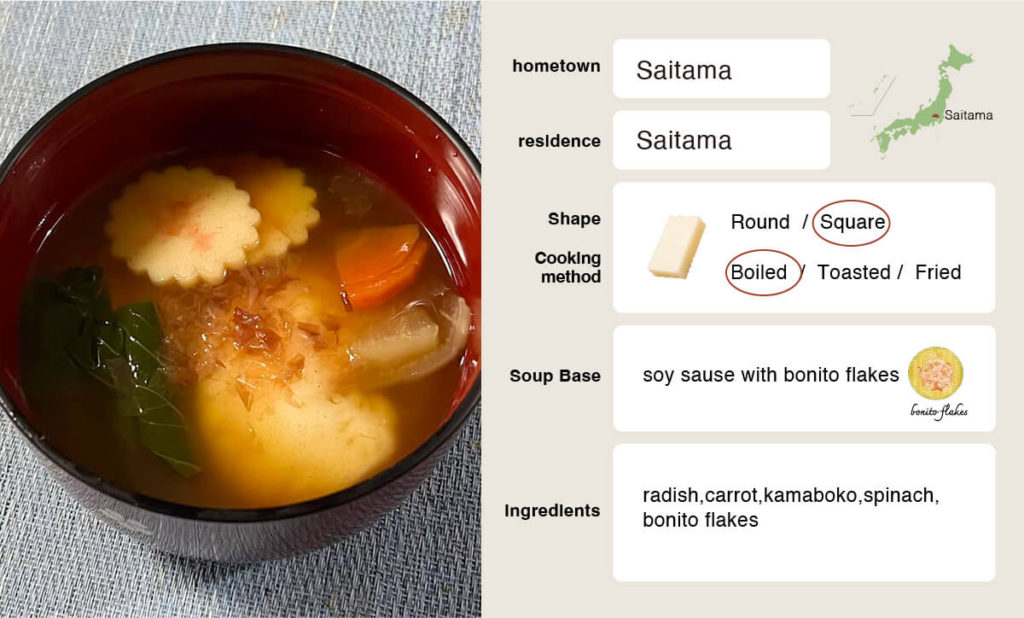
Since his father had relatives in Shizuoka Prefecture, he preferred boiled rice cakes to baked ones. So his family put boiled rice cakes in the bowl.

She is from Okayama and now lives in Saitama. She used to make a white miso ozoni, but now she makes a clear soup ozoni.

Both husband and wife are from the Kansai region, and the ozoni is a round rice cake with white miso paste. The carrots are stuffed with Chinese yam.

The Tokai area is a region where simple ozoni is eaten. It seems that the greens to be added to the ozoni vary from region to region, such as native species. Use boiled square rice cakes.

It was the only ozoni with “fried mochi” among those who provided information this time. This ozoni was made by a person from Shizuoka, whose father is from Kyushu and whose mother is from Yamanashi. She doesn’t know where this ozoni originated, but her family loves it.

Nagoya is a region with a distinctive food culture characterized by the rich flavor of “Nagoya-meshi,” such as miso nikomi udon, hitsu-mabushi, and miso pork cutlet, but ozoni is very simple. The greens, called “Shogatu-na (正月菜)” or “Mochi-na (餅菜),” are endemic to this region and are similar to komatsuna.

The southern part of Gifu Prefecture, adjacent to Aichi Prefecture, is located in the same Nobi Plain (濃尾平野), and the style of ozoni is almost the same as Nagoya style ozoni.

In the Hokuriku region facing the Sea of Japan in central Japan, there is a boundary between “the Miso Soup cultural sphere” and “the clear Soup cultural sphere” and between “the round mochi cultural sphere” and “the square mochi cultural sphere”.

Toyama consumes the largest amount of kelp in Japan. They also use kelp when boiling rice cakes for ozoni. This way, the mochi is less likely to fall apart.

Ozoni in Ishikawa Prefecture, which is well known for Kaga Hyakumangoku, is very simple. In the past, the Kaga clan had a rich food culture, so simple ozoni was favored for the New Year.

Fukui, which is closest to Kyoto in the Hokuriku region, has a white miso round rice cake with plenty of dried bonito flakes on top.

Ozoni originated in Kyoto. The Kansai region, where Kyoto is located, was influenced by Kyoto’s food culture, and the white miso-based culture spread.

Ozoni with round rice cake made with white miso paste made by a person born and raised in Kyoto. Various wishes are also expressed in the ingredients. Round rice cakes are for family happiness, taro, which produces a lot of baby potatoes, is for prosperity of offspring, and daikon radish, when cut round, signifies happiness, and when cut in a tortoise shell shape, signifies longevity.The red kintoki carrot is put in as an amulet to ward off evil.

This is also the Kyoto native’s ozoni, but the only ingredients are rice cake and dried bonito flakes.These bowls are used only for eating ozoni.

The family members prefer to bake the rice cakes a little and boil them.
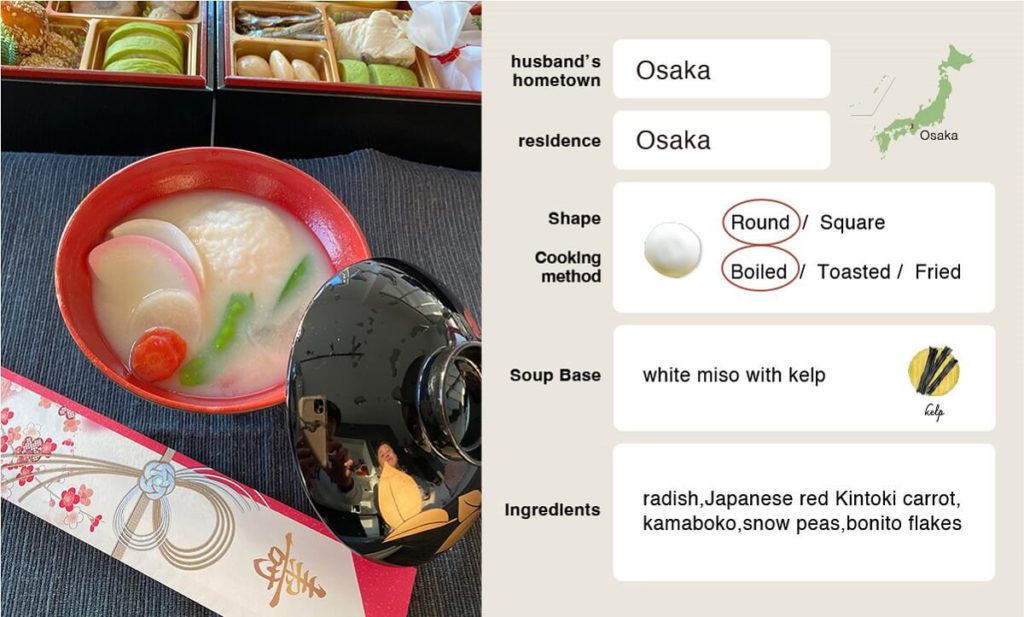
The woman who made this ozoni was born in Osaka, but her parents are from the Kanto region, so she had eaten Kanto-style ozoni with rice cakes made with clear soup stock and square rice cakes until she got married. She married a man from Osaka, and at the beginning of their marriage, fights broke out over whether to have Kansai-style ozoni or Kanto-style ozoni. They now eat Kansai-style ozoni.

She lives in Osaka, but her parents are from the Kanto region, so the ozoni is a Kanto style clear soup with baked rice cake.

Residents of Kobe City, Hyogo Prefecture, eat ozoni with white miso on the first day and clear soup on the second day. Both use round rice cakes.This probably originates from Osaka’s “Akinai Zoni.”Osaka, which prospered as a city of commerce (=商い Akinai), ate different ozoni on the first and second days of the festival in order to “never get bored” (=飽きない Akinai).

A woman in Wakayama puts Aonori and dried bonito flakes on Kansai-style ozoni. Her husband was surprised when he saw this ozoni for the first time.

The reason why thin daikon radish is found in the Kansai people’s ozoni introduced so far is because “Iwai-daikon (祝い大根)” which is thinner than regular daikon, is sold in the Kansai region at the end of the year.

Shikoku is the smallest of Japan’s major islands, but because most of its borders are separated by steep mountains, each prefecture has its own unique ozoni.

This is my family’s ozoni, born and raised in Tokushima. You can see how similar it is to Kansai’s ozoni. Across the sea is Osaka, known as the “The Nonpareil Kitchen (天下の台所),” and Tokushima has been strongly influenced by Kansai culture since the days when shipping was the mainstream.

In the same Tokushima Prefecture, ozoni from the mountainous Iya (祖谷) region uses hard tofu instead of mochi. The Iya region, with its high elevation and lack of flat land, was not suited to rice cultivation, and the staple foods of the people were barley, millet, and buckwheat noodles grown on the few cultivated lands. Iwadofu, made from large quantities of soybeans and concentrated with protein, was an indispensable source of nutrition.

Kagawa Prefecture’s ozoni is a rice cake filled with red bean paste in a white miso soup. Kagawa people are particular about this bean paste mochi, and at the end of the year, supermarkets line up with two kinds of bean paste mochi. One is a very sweet type to put in ozoni. The other is a slightly salty type of rice cake with red bean paste that is baked and eaten as is. The broth is made from iriko, which is also used in Sanuki udon noodles,a specialty of Kagawa.

Ozoni in Kochi is a clear soup with bonito broth. Many families use square rice cakes, which is unusual in western Japan. The reason for the popularity of square mochi is thought to be due to the influence of Yamauchi Kazutoyo, the feudal lord who ruled Kochi during the Edo period because he was from Owari (now the Aichi Prefecture), where square mochi was used.

In the Chugoku region, different ozoni are made in the Sanyo region facing the Seto Inland Sea and in the San’in region facing the Sea of Japan.
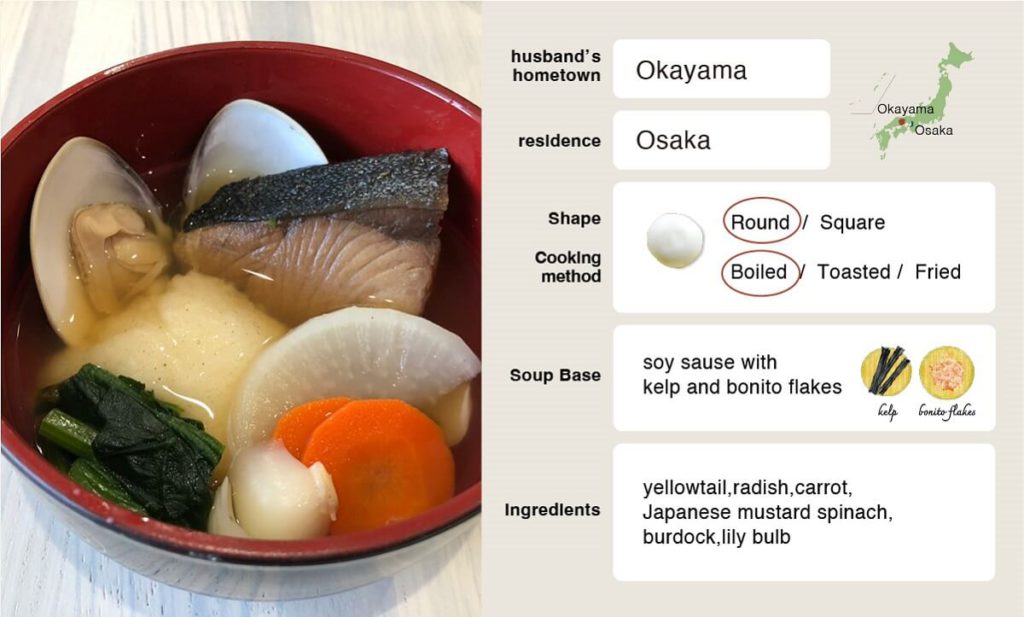
A woman living in Osaka, whose father is from Okayama Prefecture and whose mother is from Hiroshima Prefecture, has passed down their respective influences on ozoni. In addition to rice cakes and vegetables, the clear broth is filled with seafood such as amberjack and clams.

Hiroshima is the home to oysters, so ozoni also includes oysters.

A man from Tottori Prefecture, whose family home is located at the foot of Mt. Daisen, has been eating red bean soup with soft-boiled round rice cakes in it. Since ancient times, the red color of adzuki beans was believed to have the power to ward off evil spirits, so they have been used as food for celebrations.
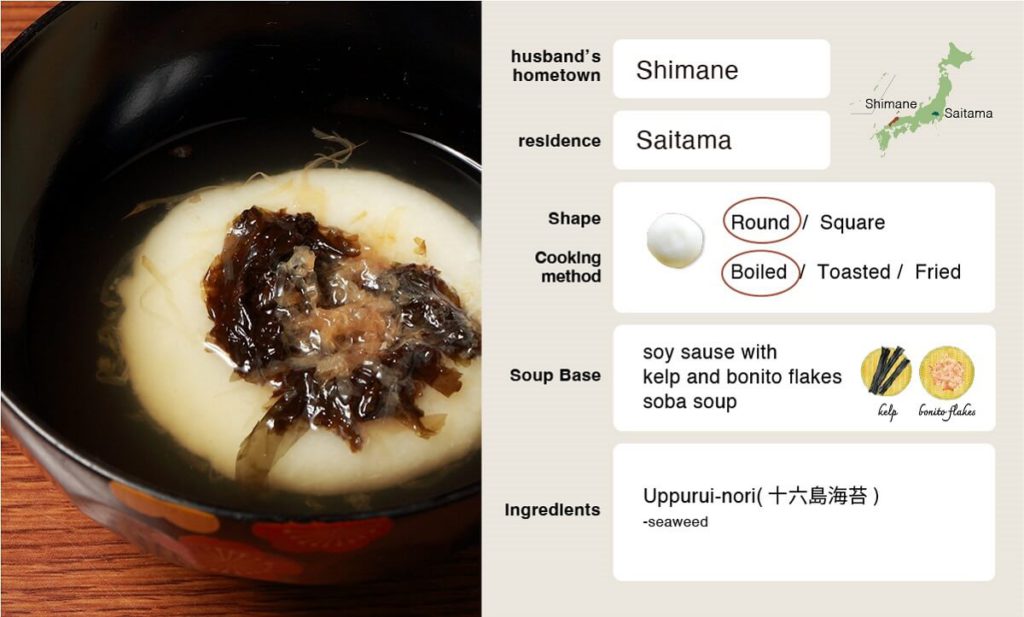
This is a type of ozoni from the Izumo region of Shimane Prefecture. Boiled round rice cakes and Iwanori (岩のり) are put into the bowl, and people eat it with boiled water and buckwheat noodle soup.

In Kyushu, three people gave me information from Fukuoka, Nagasaki, and Kagoshima, and each of them had different characteristics of ozoni.

“Hakata Zoni” is a traditional Fukuoka-style soup with broth made from grilled sardines (flying fish), traditional vegetable “Katsuna (カツオ菜)” and “yellowtail,” a fish that brings good luck for success in life. Many families boil rice cakes, but there are also families that bake them.

His wife has inherited the taste of the ozoni that her mother used to make for New Year’s in Sasebo City, Nagasaki Prefecture. She makes it every year!
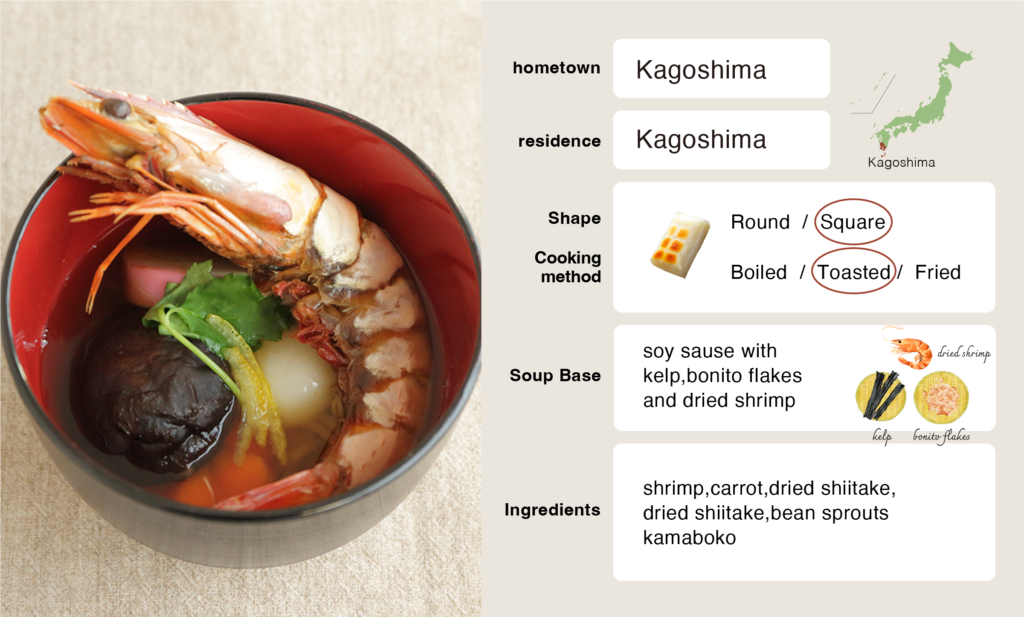
Kagoshima Prefecture’s ozoni, called “Satsuma Ebi Zoni (薩摩えび雑煮),” is characterized by shrimp so large that they protrude from the bowl. The shrimp is wished to live long until its waist bends. Half of the families use round, and half use square mochi.

In Okinawa, there isn’t a big culture of eating ozoni. Instead, for New Year’s, many families in Okinawa eat “Nakami-jiru (中身汁),” made from pork offal.
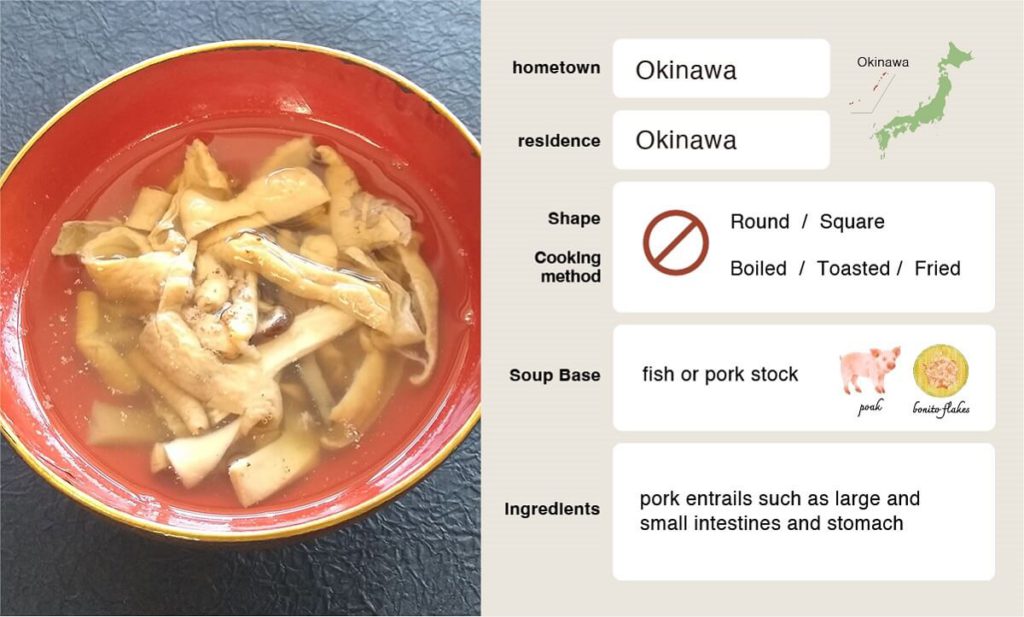

Many Japanese people living abroad also make ozoni on New Year’s Day.

Two HAPA Buddies living in Indiana, U.S.A., celebrated New Year’s together this year, making ozoni from their respective hometowns. In Indiana, komatsuna is not available, so they substituted spinach.

This ozoni was made by a native of Hakone Town, Kanagawa Prefecture, who lives in Los Angeles. She substituted taro for Yatsugashira (八頭) because Yatsugashira is not available in L.A.

A woman living in Melbourne, Australia, where New Year’s Day is in mid-summer, is from Aichi Prefecture, and her husband is from Sendai City, Miyagi Prefecture. In Melbourne, she makes Aichi-style ozoni.
Stories Stuffed in ozoni
Did you feel the diversity of Japanese ozoni?
However, remember that the ozoni introduced here showcases only a small part of all the many types of ozoni made and enjoyed in Japan. Each region and each family makes various kinds of ozoni every New Year.

Most Japanese people celebrate New Year’s with family and relatives and rarely eat ozoni from other people’s homes, even if they are friends. These days, it has become usual to outsource many dishes from catering or takeout ordering, such as “osechi” eaten with ozoni at New Year’s, “Toshikoshi soba” eaten at the end of the year, and “sekihan” (red rice) eaten during celebrations. I think ozoni is a dish that has remained in a rare and unique form that has been passed down from one family generation to the next.
If there is a Japanese person you would like to get to know better, please ask them what kind of ozoni they eat. From a bowl of ozoni, you can start to see not only the culture of someone’s hometown, but also the person’s family history.
Please also see these links:
I’m a freelance editor and director based in Tokushima, Shikoku.
Travel is my passion.I love the time when the extraordinary life of a traveler and the everyday life of the people who live there intersect.
I mainly would like to share with you the lifestyle of the people of Shikoku and the sights to see.


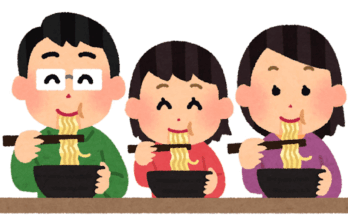


 HTJ has a YouTube page! Check it out
HTJ has a YouTube page! Check it out
This is super interesting and informative. I didn’t realize there were so many variations. I’m making Ozoni this year as I’m taking over for the older generation and my family has always made a clam ozoni, which I cannot find in your guide. Could it be a Hawaii thing? My family members are sure it’s “supposed to be” that way. Lol.